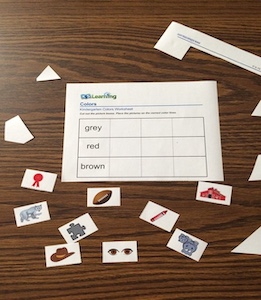Cortical/Cerebral Visual Impairment (CVI) Fundamentals
Description
Cortical/Cerebral Visual Impairment (CVI), is a brain-based neurological condition where visual processing is affected due to damage or dysfunction in the brain’s visual pathways. This may also be referred to as Neurological Visual Impairment (NVI). Unlike other types of visual impairment, CVI arises from issues in the brain rather than the eyes themselves, impacting how visual information is interpreted and processed.
Why Try Something New?
Understanding the unique characteristics of a student with CVI can significantly enhance their educational experience. Tailoring teaching strategies to specific needs not only supports learning and development but also helps educators create more inclusive and effective classroom environments. Recognizing and addressing these needs can lead to improved outcomes and a more positive experience for everyone involved.
What is Cortical Visual Impairment (CVI)?
CVI is the leading cause of childhood blindness and low vision, resulting from damage to the brain's visual pathways or processing areas. CVI is a lifelong, brain-based condition where individuals struggle with visual attention and recognition, making it difficult to interpret and interact with their environment.
Common visual behaviors associated with CVI include difficulties with facial recognition, hand-eye coordination, and integrating visual information with other senses. While these challenges can change and improve over time, they persist throughout life. Individuals with CVI often develop unique compensatory skills to navigate their visual world. Therefore, ongoing and sustained support is essential for managing CVI effectively.
People with CVI experience visual fatigue, and might find it challenging to process what they see. Visual fatigue is different for each individual with CVI, but can be caused by cluttered spaces and extra noise. A common behavior associated with visual fatigue may include taking a visual break. During a visual break a student may close their eyes or look away from faces, materials, or objects.
Watch the following video from the Perkins School for the Blind to learn about what it is like to have CVI.
How is CVI Diagnosed and Assessed?
Diagnosis
A CVI diagnosis is made by a medical professional, such as a pediatric ophthalmologist, neurologist, neuro-ophthalmologist, optometrist, or clinical low vision specialist familiar with CVI's visual behaviors. Teachers of the Visual Impaired (TVI) or other school personnel cannot diagnose CVI, but can assist with evaluation by sharing detailed information about the student’s visual history, including how their visual skills vary throughout the day, across different tasks, and in various settings. This comprehensive information aids in understanding the student’s specific challenges and needs.
The diagnosis of CVI generally involves meeting three criteria:
1. History of Neurological Impact: This includes a history of impact or injury to the brain, such as a stroke, traumatic brain injury, or cerebral palsy.
2. Abnormal Visual Behaviors: These behaviors cannot be fully explained by standard eye exams. Observations might include unusual visual responses or difficulties with visual tasks that are not due to eye health issues.
3. Unique Visual Characteristics: Specific visual traits associated with CVI, such as difficulties with visual recognition, sensitivity to visual stimuli, or problems with visual attention and tracking, are present.
These criteria help identify CVI and differentiate it from other types of visual impairments.
Want to learn more? Check out this article ‘How is CVI Diagnosed?’ from the Perkins School for the Blind CVI Now webpage.
Educational Assessment
Once a student receives a CVI diagnosis from a medical professional, a TVI should complete a comprehensive Functional Vision Assessment in the educational setting.To support the TVI in this process, the educational team (including parents/caregivers), should provide detailed information about the student's visual behaviors and usage. Examples of information that should be shared include:
- conditions under which the student utilizes their vision, and
- optimal times of day when the student is most visually engaged.
What can Educational Teams do to support students with CVI?
Having a formal diagnosis for CVI is ideal for developing a precise and targeted educational plan. However, even in the absence of a formal diagnosis, there are several proactive steps educational teams can take to support a student suspected of having CVI effectively. Educational teams can use the results of a functional vision assessment to help design the learning environment to meet the individual needs of the student. Educational teams should engage in ongoing collaboration as they purposely plan for the student considering the following areas: Consider the following areas:
Physical Space:
Evaluate your classroom to identify areas that may benefit from decluttering. In some cases, incorporating a simple solution, such as draping a piece of black fabric, can transform the space from visually overwhelming to an ideal learning environment.
Noise:
Minimize unnecessary auditory stimuli which may enhance your student’s ability to use their vision effectively. Competing sensory inputs may lead to sensory overload, causing some students to close their eyes to reduce distractions. To improve visual focus, ensure that music, videos, and side conversations are minimized or turned off when you need the student to visually engage.
Clothing:
The choice of attire can significantly impact a student with CVI. Brightly colored or highly patterned clothing may be visually overwhelming. Opt for solid, dark-colored, and non-patterned clothing to minimize visual distraction. Additionally, consider using a black smock or apron during periods when you want the student to focus visually.
For more information and ideas on how to adapt your classroom, check out this article, 'These 9 Easy Classroom Adaptations Can Help Kids with CVI' from the Perkins School for the Blind.
| Non-Example | Example | |
|---|---|---|
| Comparison 1: |
|
|
| Comparison 2: |
|
|
Where can I learn more?
The following resources offer free, publicly accessible information and resources related to CVI and things you can do in the classroom.
- Adapting worksheets for CVI – Perkins School for the Blind Learn Learn why worksheets are inaccessible for many with CVI and ideas for making worksheet learning accessible
- Modify on the Fly for CVI – Paths to Literacy provides resources for teachers and families on how to modify materials for learners with CVI.
- Pediatric Cortical Visual Impairment Society
The mission of PCVIS is to transform outcomes for children and youth with CVI by advocating for research, policy, education, practice, heightened awareness and understanding of this brain-based visual impairment.
- Michigan Department of Education - Low Incidence Outreach (MDE-LIO) provides consultation, training, and resources to Michigan families and educational teams.
- MDE-LIO Resources includes tools specifically for students with CVI
- Augmentative and Alternative Communication (AAC) and CVI Quick Win provides an opportunity to learn about considerations educators should take when introducing and utilizing augmentative and alternative communication for students with CVI.



